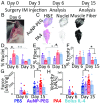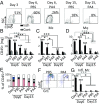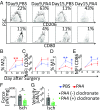Functional muscle recovery with nanoparticle-directed M2 macrophage polarization in mice
- PMID: 30275293
- PMCID: PMC6196479
- DOI: 10.1073/pnas.1806908115
Functional muscle recovery with nanoparticle-directed M2 macrophage polarization in mice
Abstract
Persistence of inflammation, and associated limits in tissue regeneration, are believed to be due in part to the imbalance of M1 over M2 macrophages. Here, we hypothesized that providing a sustained source of an antiinflammatory polarizing cytokine would shift the balance of macrophages at a site of tissue damage to improve functional regeneration. Specifically, IL-4-conjugated gold nanoparticles (PA4) were injected into injured murine skeletal muscle, resulting in improved histology and an ∼40% increase in muscle force compared with mice treated with vehicle only. Macrophages were the predominant infiltrating immune cell, and treatment with PA4 resulted in an approximately twofold increase in the percentage of macrophages expressing the M2a phenotype and an approximately twofold decrease in M1 macrophages, compared with mice treated with vehicle only. Intramuscular injection of soluble IL-4 did not shift macrophage polarization or result in functional muscle improvements. Depletion of monocytes/macrophages eliminated the therapeutic effects of PA4, suggesting that improvement in muscle function was the result of M2-shifted macrophage polarization. The ability of PA4 to direct macrophage polarization in vivo may be beneficial in the treatment of many injuries and inflammatory diseases.
Keywords: IL-4; macrophage polarization; muscle regeneration; nanomedicine; regenerative medicine.
Conflict of interest statement
The authors declare no conflict of interest.
Figures






References
-
- Mantovani A, Biswas SK, Galdiero MR, Sica A, Locati M. Macrophage plasticity and polarization in tissue repair and remodelling. J Pathol. 2013;229:176–185. - PubMed
-
- Mantovani A, Garlanda C, Locati M. Macrophage diversity and polarization in atherosclerosis: A question of balance. Arterioscler Thromb Vasc Biol. 2009;29:1419–1423. - PubMed
Publication types
MeSH terms
Substances
Grants and funding
LinkOut - more resources
Full Text Sources
Other Literature Sources

